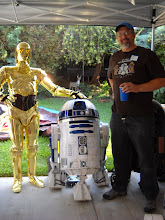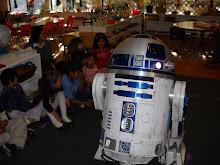
The tape helps prevent blowout with the outer layer of the plywood.

I also finished gluing the curved pieces to the center legs:

Then I cleaned the excess glue up off of those, and used the orbital sander to bring down the edges of the MDF pieces where they overlapped. I got the MDF pieces all sanded flush and incorporated. I also put a 1/2" axle hole in them. Be sure to clamp a scrap to the back side when you drill to prevent blowout. The center legs are almost finished. I'll go over them once more for any gaps or dings that need to be filled, fill them, finish sand, and then I'll put a coat of primer on them to see to what extent any seems or joints are showing through. You can also see the modification on the tip of the leg here. This extra wing will rest down flush into the foot shell groove and provide a stable joint between leg and foot. And since this is on the back of the leg, it would still be possible to straighten this leg up for an upright posture:

I also finished gluing and nailing the four ankle panels to the bottom of each leg. And today I cleaned up the glue and then sanded the sides on the belt sander to get a good clean joint.

Once that was done, I could finally lay out the lines for the leg tip:

I roughed those cuts in on the band saw.

And then finished them down close on the belt sander with the belt tipped up to 90 degrees. The end results are starting to look familiar:

So what remains is to mount those curved pieces on the right onto the ankles, cut the round hole into the shoulders for the shoulder detail, and then do some finish filling and sanding.
One problem I've been having is blowout on the the outer finish layer of the plywood. I don't know if I got a sheet that had too little glue in the final layer or if the final layer is just too thin, but some spots are really fragile and friable. The worst example is when I made this cut through with the band saw:

It all blew off of there so suddenly an severely that I have to think that they messed up on the glue here. But I'm not sure. This sucks as it produces a lot more work for me and it lowers my confidence about the rest of the pieces enduring use over the long term. I have a couple of options to fix it (the other spots are much less bad than this). I can try to fill the region in with glue, body putty, or fiberglass/resin Bondo and then sand it in to blend. I think the last option will make the best looking and most durable results. I'll work on that this week. I also think that once I get some primer on there to seal these up, and then their new owners get several more coats of primer and several finish coats of paint, that paint will cure and form a consolidated skin that will be more durable. The wood won't do this once it's painted right. But I have to be extra careful until then.

















































